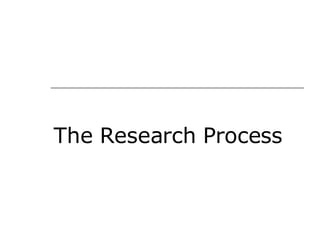Research Process
- 2. Theory Hypothesis Data Empirical Generalizations
- 3. Theory A logically interrelated set of propositions about empirical reality. Theory shapes research and research shapes theory. Analytical Framework/Guide to Research
- 4. Deterrence Theory Prevalent in Criminological Research Evaluates the impact of punishment on crime. Expects punishment to deter crime in two ways: Specific vs. General Deterrence
- 5. Research Topic/Question Domestic Violence is a prevalent social problem in the Belizean society; it is a problem that has tragically escalated over the years, thus the issue demands much attention and societal redress. To what extent does arresting spouse abusers reduces their likelihood of re-offending?
- 6. Hypothesis A tentative statement about empirical reality, involving a relationship between two or more variables. Consists of an independent variable(s) and dependent variable(s). Arresting an abusive spouse after a domestic dispute decreases the likelihood of he/she re-offending.
- 7. Conceptualization/Operationalization Outline and Define Variables Indicate measurement of those variables. Domestic Abuse: Definition Operationalize: Crime Statistics Social Research
- 8. Literature Review Find out everything you can about your topic/hypothesis. Read and analyze other research projects: library, journals, web documents etc. On going process: From beginning to end.
- 9. Methodology Developing the research design. Quantitative, Qualitative or Triangulation How am I going to gather data to test my hypothesis? What tools/data collection instruments will I use to gather my data?
- 10. Methodologies Quantitative Surveys Experiments Qualitative Interviews Focus Groups Participant Observation
- 11. Sampling Several types of sampling techniques. Target population Generate sample or subset Generalizability and Sampling go hand in hand. Representative sampling
- 12. Data Collection The fun part!!! Going out into the field and gathering the data. Many obstacles and hindrances may come about. Strategizing and contingency planning is necessary.
- 13. Data Analysis Putting things into perspective Turning raw data into information Quantitative and Qualitative Analysis Do my data support/dismiss by tentative statement about observable reality (hypothesis)?
- 14. Presenting the Data Written Presentation: Charts; Graphs; Tables Oral Presentation: Audio and Visual Aids; Power point etc.
- 15. Conclusions Provide a clear synopsis of your findings. Summarize the research experience Present ideas for future research Make formal recommendations based on your findings
- 16. References Giving credit where it is due. Proper citations throughout the research project is imperative. Social Sciences: APA
- 17. Appendix Supplemental Data and Information to enhance your research Copy of questionnaire instrument Local conference reports Statistical data International or Regional Trends
- 18. Publication Scholarly Journals Social Science Research Journals: Criminology ; Criminology and Public Policy ; Criminology and Criminal Justice Organization of Interests School Purposes
- 19. Back to Theory: The research cycle starts again. Developing new theory or building upon old theory. Deterrence Theory: Arresting abusive spouse works to deter re-offending only in high status/economic class communities.


















